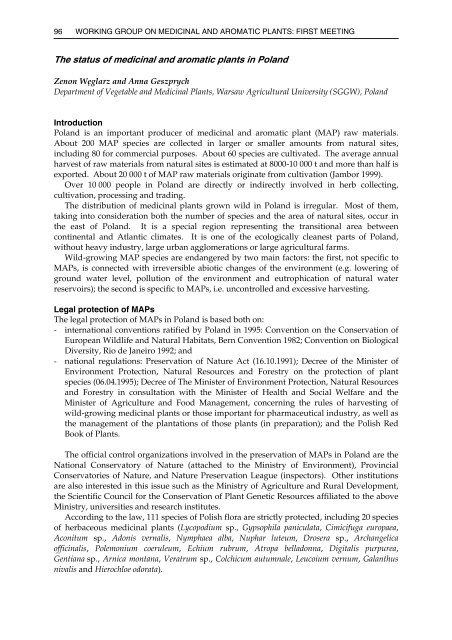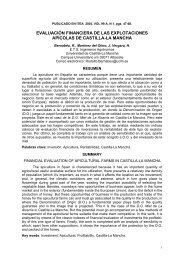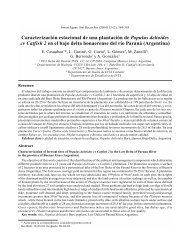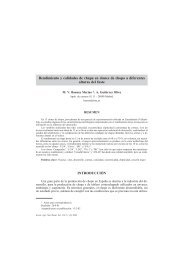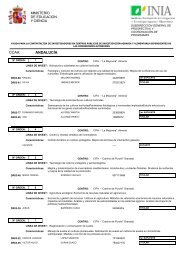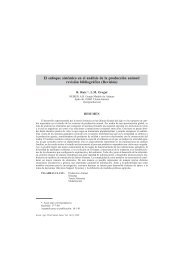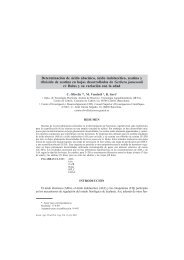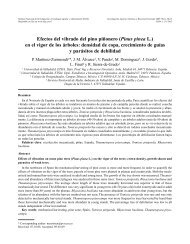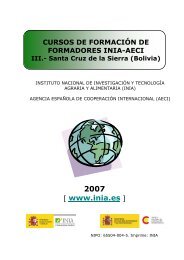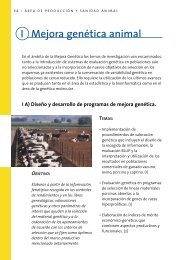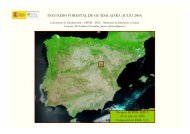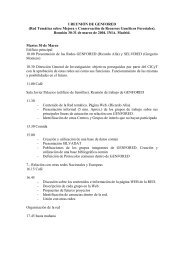Status of medicinal and aromatic plants in - Inia
Status of medicinal and aromatic plants in - Inia
Status of medicinal and aromatic plants in - Inia
You also want an ePaper? Increase the reach of your titles
YUMPU automatically turns print PDFs into web optimized ePapers that Google loves.
96<br />
WORKING GROUP ON MEDICINAL AND AROMATIC PLANTS: FIRST MEETING<br />
The status <strong>of</strong> <strong>medic<strong>in</strong>al</strong> <strong>and</strong> <strong>aromatic</strong> <strong>plants</strong> <strong>in</strong> Pol<strong>and</strong><br />
Zenon Węglarz <strong>and</strong> Anna Geszprych<br />
Department <strong>of</strong> Vegetable <strong>and</strong> Medic<strong>in</strong>al Plants, Warsaw Agricultural University (SGGW), Pol<strong>and</strong><br />
Introduction<br />
Pol<strong>and</strong> is an important producer <strong>of</strong> <strong>medic<strong>in</strong>al</strong> <strong>and</strong> <strong>aromatic</strong> plant (MAP) raw materials.<br />
About 200 MAP species are collected <strong>in</strong> larger or smaller amounts from natural sites,<br />
<strong>in</strong>clud<strong>in</strong>g 80 for commercial purposes. About 60 species are cultivated. The average annual<br />
harvest <strong>of</strong> raw materials from natural sites is estimated at 8000-10 000 t <strong>and</strong> more than half is<br />
exported. About 20 000 t <strong>of</strong> MAP raw materials orig<strong>in</strong>ate from cultivation (Jambor 1999).<br />
Over 10 000 people <strong>in</strong> Pol<strong>and</strong> are directly or <strong>in</strong>directly <strong>in</strong>volved <strong>in</strong> herb collect<strong>in</strong>g,<br />
cultivation, process<strong>in</strong>g <strong>and</strong> trad<strong>in</strong>g.<br />
The distribution <strong>of</strong> <strong>medic<strong>in</strong>al</strong> <strong>plants</strong> grown wild <strong>in</strong> Pol<strong>and</strong> is irregular. Most <strong>of</strong> them,<br />
tak<strong>in</strong>g <strong>in</strong>to consideration both the number <strong>of</strong> species <strong>and</strong> the area <strong>of</strong> natural sites, occur <strong>in</strong><br />
the east <strong>of</strong> Pol<strong>and</strong>. It is a special region represent<strong>in</strong>g the transitional area between<br />
cont<strong>in</strong>ental <strong>and</strong> Atlantic climates. It is one <strong>of</strong> the ecologically cleanest parts <strong>of</strong> Pol<strong>and</strong>,<br />
without heavy <strong>in</strong>dustry, large urban agglomerations or large agricultural farms.<br />
Wild-grow<strong>in</strong>g MAP species are endangered by two ma<strong>in</strong> factors: the first, not specific to<br />
MAPs, is connected with irreversible abiotic changes <strong>of</strong> the environment (e.g. lower<strong>in</strong>g <strong>of</strong><br />
ground water level, pollution <strong>of</strong> the environment <strong>and</strong> eutrophication <strong>of</strong> natural water<br />
reservoirs); the second is specific to MAPs, i.e. uncontrolled <strong>and</strong> excessive harvest<strong>in</strong>g.<br />
Legal protection <strong>of</strong> MAPs<br />
The legal protection <strong>of</strong> MAPs <strong>in</strong> Pol<strong>and</strong> is based both on:<br />
- <strong>in</strong>ternational conventions ratified by Pol<strong>and</strong> <strong>in</strong> 1995: Convention on the Conservation <strong>of</strong><br />
European Wildlife <strong>and</strong> Natural Habitats, Bern Convention 1982; Convention on Biological<br />
Diversity, Rio de Janeiro 1992; <strong>and</strong><br />
- national regulations: Preservation <strong>of</strong> Nature Act (16.10.1991); Decree <strong>of</strong> the M<strong>in</strong>ister <strong>of</strong><br />
Environment Protection, Natural Resources <strong>and</strong> Forestry on the protection <strong>of</strong> plant<br />
species (06.04.1995); Decree <strong>of</strong> The M<strong>in</strong>ister <strong>of</strong> Environment Protection, Natural Resources<br />
<strong>and</strong> Forestry <strong>in</strong> consultation with the M<strong>in</strong>ister <strong>of</strong> Health <strong>and</strong> Social Welfare <strong>and</strong> the<br />
M<strong>in</strong>ister <strong>of</strong> Agriculture <strong>and</strong> Food Management, concern<strong>in</strong>g the rules <strong>of</strong> harvest<strong>in</strong>g <strong>of</strong><br />
wild-grow<strong>in</strong>g <strong>medic<strong>in</strong>al</strong> <strong>plants</strong> or those important for pharmaceutical <strong>in</strong>dustry, as well as<br />
the management <strong>of</strong> the plantations <strong>of</strong> those <strong>plants</strong> (<strong>in</strong> preparation); <strong>and</strong> the Polish Red<br />
Book <strong>of</strong> Plants.<br />
The <strong>of</strong>ficial control organizations <strong>in</strong>volved <strong>in</strong> the preservation <strong>of</strong> MAPs <strong>in</strong> Pol<strong>and</strong> are the<br />
National Conservatory <strong>of</strong> Nature (attached to the M<strong>in</strong>istry <strong>of</strong> Environment), Prov<strong>in</strong>cial<br />
Conservatories <strong>of</strong> Nature, <strong>and</strong> Nature Preservation League (<strong>in</strong>spectors). Other <strong>in</strong>stitutions<br />
are also <strong>in</strong>terested <strong>in</strong> this issue such as the M<strong>in</strong>istry <strong>of</strong> Agriculture <strong>and</strong> Rural Development,<br />
the Scientific Council for the Conservation <strong>of</strong> Plant Genetic Resources affiliated to the above<br />
M<strong>in</strong>istry, universities <strong>and</strong> research <strong>in</strong>stitutes.<br />
Accord<strong>in</strong>g to the law, 111 species <strong>of</strong> Polish flora are strictly protected, <strong>in</strong>clud<strong>in</strong>g 20 species<br />
<strong>of</strong> herbaceous <strong>medic<strong>in</strong>al</strong> <strong>plants</strong> (Lycopodium sp., Gypsophila paniculata, Cimicifuga europaea,<br />
Aconitum sp., Adonis vernalis, Nymphaea alba, Nuphar luteum, Drosera sp., Archangelica<br />
<strong>of</strong>fic<strong>in</strong>alis, Polemonium coeruleum, Echium rubrum, Atropa belladonna, Digitalis purpurea,<br />
Gentiana sp., Arnica montana, Veratrum sp., Colchicum autumnale, Leucoium vernum, Galanthus<br />
nivalis <strong>and</strong> Hierochloe odorata).


